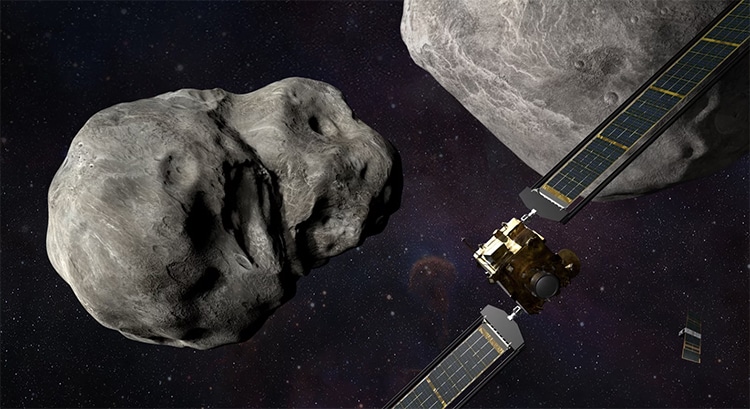NASA Just Made History by Successfully Crashing a Spacecraft Into an Asteroid

Artist's conception of the DART spacecraft approaching Didymos and Dimorphos. (Photo: NASA/Johns Hopkins APL/Steve Gribben)
Sixty-six million years ago, an asteroid hurtled into Earth. The impact of the enormous chunk of rock created a gigantic crater under what is now known as the Yucatán Peninsula in Mexico. The asteroid sent debris flying, which clouded the skies around the globe. Tidal waves bombarded shorelines. The age of the dinosaurs came to a devastating end in a mass extinction event. Could this happen again? NASA, at least, hopes to develop planetary defense systems to divert asteroids, thereby saving mankind from the dinosaur's bitter end. Their first mission—the Double Asteroid Redirection Test (DART)—has successfully begun with the impact of a spacecraft into an asteroid seven million miles from Earth.
For the past seven years, NASA has poured $300 million dollars into a plan for planetary defense. The agency constructed a special spacecraft that launched in November of 2021. It set out to find Didymos, a large asteroid of the Apollo group. The goal was to smash the craft into Didymos. By the principles of physics, this “space force” should knock the asteroid off its typical orbit by a slight amount. While this is only a test run and Earth is not in danger, the same principle could be used if an asteroid is predicted to collide with Earth along the path of either body's orbit.
While initially aiming for Didymos, the craft took aim for a smaller asteroid orbiting it known as Dimorphos. This sudden change occurred only an hour before impact. As the craft approached the asteroid, NASA also lost steering control. However, the impact was successful. The last image returned to Earth was of the asteroid's rocky surface two seconds before the collision.
Dimorphos, which is only 525 feet across, is seven million miles from Earth. NASA predicts the impact will shorten the orbital time of Dimorphus around Didymos by about ten minutes. The effects of the crash will be monitored by telescopes around the world and a follow-up mission known as Hera in a few years. In the future, small orbital changes could be enough to “miss” Earth.
If successful in changing the asteroid's orbit even slightly, the technique is revolutionary. “We're moving an asteroid. We are changing the motion of a natural celestial body in space. Humanity has never done that before,” Tom Statler, NASA's DART program scientist, remarked. “This is stuff of science fiction books and really corny episodes of Star Trek from when I was a kid, and now it's real. And that's kind of astonishing that we are actually doing that, and what that bodes for the future of what we can do.”
It may also be critical to avoiding a dinosaur-reminiscent disaster. “It's something that we need to get done so that we know what's out there and know what's coming and have adequate time to prepare for it,” said Lindley Johnson, NASA's Planetary Defense Officer. He notes that such dangerous asteroids will not be a surprise. Astronomers will have many years of notice, perhaps even hundreds, to prepare. So while we do not have to worry about an asteroid slamming into Earth at present, it's good to know NASA is preparing to defend our Earth.
In a revolutionary plan of planetary defense, NASA has collided a spacecraft with an asteroid to change its orbit.

The last complete image of asteroid moonlet Dimorphos, by the DRACO imager on NASA’s DART mission, taken about 2 seconds before impact. (Photo: NASA/Johns Hopkins APL)
ATLAS observations of the DART spacecraft impact at Didymos! pic.twitter.com/26IKwB9VSo
— ATLAS Project (@fallingstarIfA) September 27, 2022
IMPACT SUCCESS! Watch from #DARTMIssion’s DRACO Camera, as the vending machine-sized spacecraft successfully collides with asteroid Dimorphos, which is the size of a football stadium and poses no threat to Earth. pic.twitter.com/7bXipPkjWD
— NASA (@NASA) September 26, 2022
On this test run, NASA hopes to move the (safe) asteroid and shorten its orbit by ten minutes.
Related Articles:
Spectacular ‘Cartwheel Galaxy’ Captured by James Webb Space Telescope
JWST Captures Square-Shaped Ripple Rings Around a Star, Perplexing Astronomers
Scientists Develop Motor To Make Oxygen on Mars To Support Astronaut Life
Astronomers Discover an Ocean-Covered “Super-Earth” Exoplanet
READ: NASA Just Made History by Successfully Crashing a Spacecraft Into an Asteroid
0 Commentaires